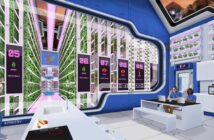A new facility to assist advances in crop science is taking shape in the Norfolk countryside.
The field experimental station at Church Farm, Bawburgh, will allow scientists at the John Innes Centre to carry out ground-breaking research in crop improvements.
Bringing together lab and field research in one location will further research in understanding how genes control plant growth in the field.
The aim is to create tools for plant breeders to produce new varieties that are more reliable, nutritious and resilient to pests and diseases
Mrs Cathy Mumford, who leads the field experimental team at the John Innes Centre, explains the need for the new facility:
“It means researchers can investigate crop genetics and their effects in an environment in which farmers would grow their crops, where every season is different unlike a glass house or controlled environment.”
“Researchers will be able to benefit from lab and field facilities that are side by side, and there will be a range of facilities under one roof.”
The new development is set in 110 hectares of farmland owned by the John Innes Centre of which 20 hectares are used each year for field research on crops and some non-crop plant species.
The 1700sqm building includes two laboratories, climate-controlled grain storage, office space for six staff, meeting rooms and storage space for agricultural equipment
Most of the funding for the £4.3m facility comes from the Biotechnology and Biological Sciences Research Council (BBSRC), with a contribution from the John Innes Foundation.
It is designed by King’s Lynn-based architects Calvert, Brain and Fraulo Ltd and the building contractors R.G Carter Construction are on track to complete the project in time for a proposed opening in July 2018.
The new building will bring together facilities that have previously been distributed across several sites, to form a hub that strengthens links between the research community and crop breeders.
On the site, a new temperature and humidity controlled store will allow the medium-term storage of seeds, the product of many years of research. This seed will be available for scientists and breeders from across the globe to use in their own crop improvement research.
Research facilities include a plant processing “dirty” laboratory where scientists can process crop samples taken from the trials fields, a “clean” laboratory which will provide access to high grade scientific facilities; and freezer storage for plant tissue samples down to minus 80 degrees.
The facility is central to the John Innes Centre strategy to deliver BBSRC-fundedresearch on Plant Health, Genes in the Environment and Designing Future Wheat, a cross institute programme spanning eight research institutes and universities.
In addition to scientists from the John Innes Centre, the facility will be used by researchers from The Sainsbury Laboratory, Quadram Institute, and the Earlham Institute all located on the Norwich Research Park.
Project leader Professor Simon Griffiths of the John Innes Centre said: “The field experimentation facility is a core capability that is fundamental to JIC science. The progression of plant research from model to field crops means that the need for field-based experimental facilities is more pressing than ever.”
Planning permission was successfully obtained from South Norfolk Council early in 2017 for the site which lies to the west of the south Norfolk village of Bawburgh. The facility replaces one previously situated at Newfound Farm, Colney on land sold for housing development. A name for the new centre is still under consideration.
“A key benefit is in efficiency of working and having everything on one site. We will be able to do much more in a facility that is custom designed for our needs,” explained Mrs Mumford.
Much of the land associated with the site is farmed by Morley Farms Ltd a commercial arm of the Morley Agricultural Foundation which supports farming in the East of England by funding agricultural research and educational projects.




